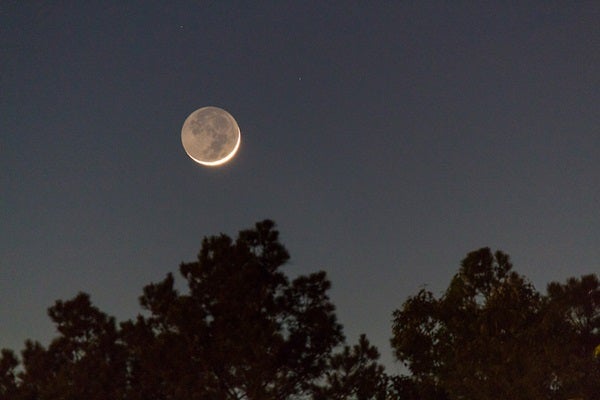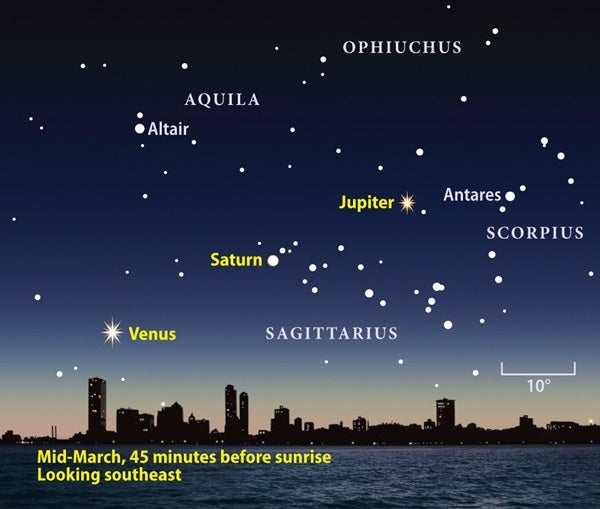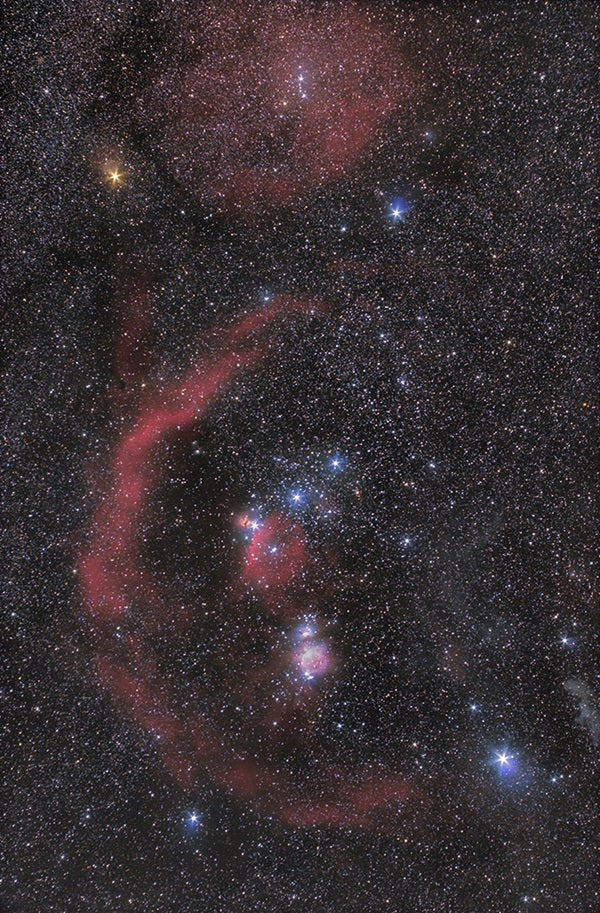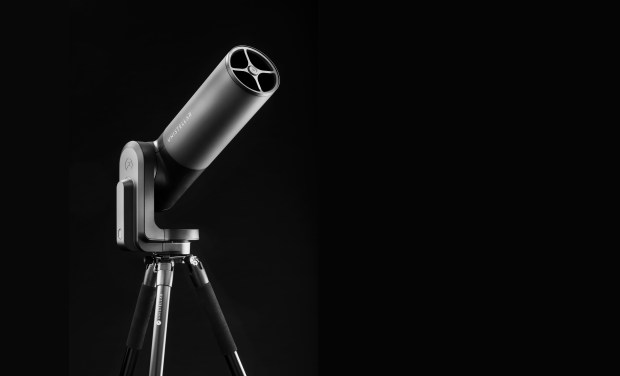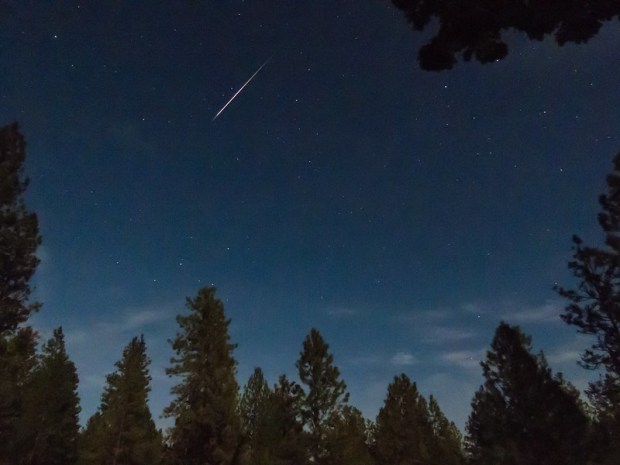With an age of 4.5 billion years, “young” might not seem an appropriate word to describe our Moon. But tonight, you have an exceptional opportunity to see what astronomers call a “young Moon” — a slender crescent visible in the early evening sky. With New Moon having occurred just two days ago, only 5 percent of our satellite’s disk appears illuminated after sunset tonight. You can find the Moon about 10° above the western horizon an hour after sunset. You should notice an ashen light faintly illuminating the Moon’s dark side. This is “earthshine” — sunlight reflected by Earth that reaches the Moon and then reflects back to our waiting eyes. March is a particularly good month to view a young Moon. Luna gains altitude quickly from night to night because the ecliptic — the apparent path of the Sun across the sky that the Moon and planets follow closely — makes a steep angle to the western horizon after sunset. It causes the Moon to gain 10° of altitude each evening despite moving only 11° eastward relative to the Sun.
Saturday, March 9
Although Saturn passed on the opposite side of the Sun from Earth just two months ago, it already appears conspicuous in the southeast before dawn. From mid-northern latitudes, the ringed planet lies more than 10° above the horizon as twilight begins. Saturn shines at magnitude 0.6 and appears significantly brighter than any of the background stars in its host constellation, Sagittarius the Archer. A telescope shows the gas giant’s 16″-diameter disk and a spectacular ring system that spans 36″ and tilts 24° to our line of sight.
Sunday, March 10
Jupiter continues to grow more prominent before dawn. The giant planet shines at magnitude –2.1 and climbs 25° high in the south-southeast by the first hint of twilight. A telescope reveals at least two conspicuous cloud belts on Jupiter’s 37″-diameter disk. In addition, the planet’s four bright moons show up as bright dots arrayed against the black sky to either side of the gas giant.
For most people in the United States and Canada, daylight saving time begins at 2 a.m. local time this morning. Set your clocks ahead one hour.
Monday, March 11
With the advent of daylight saving time, it becomes a bit easier to view Venus in the morning sky. Before daylight time began, the brilliant planet rose shortly after 4:30 a.m. local time and the Sun overwhelmed it by 6 a.m. Now, you can add an hour to those times and more easily catch a peek before you head to work or school. Venus shines at magnitude –4.0, which makes it the brightest point of light in the sky. When viewed through a telescope this morning, Venus’ disk spans 15″ and appears three-quarters lit.
The waxing crescent Moon points the way to Mars this evening. The 25-percent-lit Moon appears halfway to the zenith in the west-southwest around 8 p.m. local daylight time. Ruddy Mars lies 7° (about one binocular field) to Luna’s right. The two remain paired until they set shortly before midnight. Mars stands out even more on other evenings this week when the Moon isn’t nearby. The magnitude 1.3 Red Planet resides among the fainter background stars of Aries the Ram. Unfortunately, when viewed through a telescope, Mars shows little if any detail on its 5″-diameter disk.
Tuesday, March 12
This evening, the waxing Moon sits on the western edge of the Hyades star cluster in Taurus the Bull. The 35-percent-lit crescent appears to the lower right of 1st-magnitude Aldebaran, the orange sun that marks the upper left corner of the V-shaped Hyades. In reality, however, the bright star is a foreground object that only appears along the same line of sight as the cluster.
The three morning planets — Jupiter, Saturn, and Venus — appear equally spaced before dawn. Venus and Jupiter are the two brightest. (In fact, they are the two brightest points of light in the entire sky.) They lie 50° apart, while fainter Saturn lies exactly midway between them. If clouds interfere with your view this morning, don’t despair — to the naked eye, the alignment holds for a few days.
Thursday, March 14
You can find the First Quarter Moon high in the south as darkness falls, then watch as it sinks toward the western horizon over the next several hours. Our satellite officially reaches First Quarter phase at 6:27 a.m. EDT, and sharp-eyed observers might notice that Luna appears just a touch over halflit this evening. The Moon starts the evening among the background stars of northern Orion but passes into western Gemini by the time it sets.
As midnight approaches, look to the east for the bright star Arcturus. At magnitude 0.0, it is the second-brightest star visible from mid-northern latitudes. If you scan about 20° to the left and a little below this luminary, you should see a conspicuous semicircle of stars: the constellation Corona Borealis the Northern Crown. It’s the most prominent group of stars having a shape reminiscent of a circle, and it makes a fitting target for Pi Day. (For you non-geeks, Pi Day is 3/14 because the first three digits of the mathematical constant pi are 3.14. Pi is the ratio of a circle’s circumference to its diameter, so today we celebrate all things circular.)
Mercury reaches inferior conjunction, passing between the Sun and Earth, at 10 p.m. EDT. The innermost planet will return to view before dawn at the end of March.
Friday, March 15
For those of you in the Southern Hemisphere, today marks the peak of the annual Gamma Normid meteor shower. The shower’s radiant — the point from which the meteors appear to originate — lies among the background stars of the southern constellation Norma the Square. This region lies below the horizon for observers north of 40° north latitude, but those farther south should keep their eyes open. The best views will come after midnight, once the radiant climbs higher and the waxing gibbous Moon sets. The shower typically produces about 6 meteors per hour at its peak.
Saturday, March 16
Although asteroid 3 Juno reached opposition and peak visibility back in November, it remains a worthwhile target this week. Not only is it still reasonably bright — a small telescope will reveal its 9th-magnitude glow — but it also resides against the rich stellar backdrop of Orion the Hunter. This evening provides your best opportunity because the asteroid passes just 0.1° north of 5th-magnitude Pi1 (π1) Orionis. This star marks the northernmost point in Orion’s Shield.
Orion the Hunter stands out in the southwest as darkness falls all week. The conspicuous constellation appears slightly askew compared with its appearance in mid-winter’s evening sky. Now, the three-star belt is aligned parallel to the horizon while blue-white Rigel hangs directly below the belt and ruddy Betelgeuse stands directly above it.

